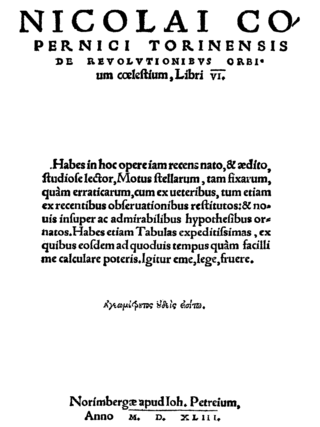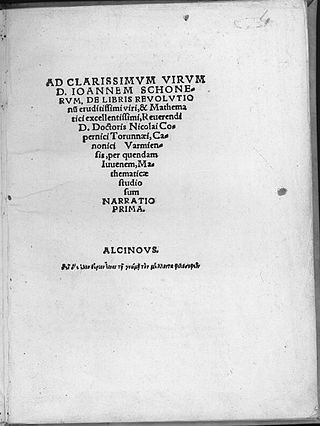
Year 1543 (MDXLIII) was a common year starting on Monday of the Julian calendar. It is one of the years sometimes referred to as an "Annus mirabilis" because of its significant publications in science, considered the start of the scientific revolution.
Domenico Maria Novara (1454–1504) was an Italian scientist.
This article contains information about the literary events and publications of 1543.

Nicolaus Copernicus was a Renaissance polymath, active as a mathematician, astronomer, and Catholic canon, who formulated a model of the universe that placed the Sun rather than Earth at its center. In all likelihood, Copernicus developed his model independently of Aristarchus of Samos, an ancient Greek astronomer who had formulated such a model some eighteen centuries earlier.

De revolutionibus orbium coelestium is the seminal work on the heliocentric theory of the astronomer Nicolaus Copernicus (1473–1543) of the Polish Renaissance. The book, first printed in 1543 in Nuremberg, Holy Roman Empire, offered an alternative model of the universe to Ptolemy's geocentric system, which had been widely accepted since ancient times.

The triquetrum was the medieval name for an ancient astronomical instrument first described by Ptolemy in the Almagest. Also known as Parallactic Rulers, it was used for determining altitudes of heavenly bodies. Ptolemy calls it a "parallactic instrument" and seems to have used it to determine the zenith distance and parallax of the Moon.
The year 1506 in science and technology included many events, some of which are listed here.
Trepidation, in now-obsolete medieval theories of astronomy, refers to hypothetical oscillation in the precession of the equinoxes. The theory was popular from the 9th to the 16th centuries.

Nikolaus von Schönberg was a German Catholic cardinal and Archbishop of Capua.

The Commentariolus is Nicolaus Copernicus's brief outline of an early version of his revolutionary heliocentric theory of the universe. After further long development of his theory, Copernicus published the mature version in 1543 in his landmark work, De revolutionibus orbium coelestium.

Johann(es) Petreius was a German printer in Nuremberg.

De libris revolutionum Copernici narratio prima, usually referred to as Narratio Prima, is an abstract of Nicolaus Copernicus' heliocentric theory, written by Georg Joachim Rheticus in 1540. It is an introduction to Copernicus's major work, De revolutionibus orbium coelestium, published in 1543, largely due to Rheticus's instigation. Narratio Prima is the first printed publication of Copernicus's theory.

Copernican heliocentrism is the astronomical model developed by Nicolaus Copernicus and published in 1543. This model positioned the Sun at the center of the Universe, motionless, with Earth and the other planets orbiting around it in circular paths, modified by epicycles, and at uniform speeds. The Copernican model displaced the geocentric model of Ptolemy that had prevailed for centuries, which had placed Earth at the center of the Universe.

The Prutenic Tables, were an ephemeris by the astronomer Erasmus Reinhold published in 1551. They are sometimes called the Prussian Tables after Albert I, Duke of Prussia, who supported Reinhold and financed the printing. Reinhold calculated this new set of astronomical tables based on Nicolaus Copernicus' De revolutionibus orbium coelestium, the epochal exposition of Copernican heliocentrism published in 1543. Throughout his explanatory canons, Reinhold used as his paradigm the position of Saturn at the birth of the Duke, on 17 May 1490. With these tables, Reinhold intended to replace the Alfonsine Tables; he added redundant tables to his new tables so that compilers of almanacs familiar with the older Alfonsine Tables could perform all the steps in an analogous manner.
Franz Rhode was a German printer of the 16th century.
The Nicolaus-Copernicus-Gesamtausgabe is a comprehensive, commented collection of works by, about, and related to Nicolaus Copernicus. The Gesamtausgabe includes Copernicus's surviving manuscripts and notes, his published writings, other authors' commentary about Copernicus and his works, a bibliography, and a biography.
Hieronymus Schreiber, also called Jerôme Schreiber, was a German doctor, mathematician and astronomer from Nuremberg.
The year 1512 in science and technology included a number of events, some of which are listed here.

Jean-Pierre Verdet is a French astronomer, historian of astronomy and mathematician.
The Wittenberg Interpretation refers to the work of astronomers and mathematicians at the University of Wittenberg in response to the heliocentric model of the Solar System proposed by Nicholas Copernicus, in his 1543 book De revolutionibus orbium coelestium. The Wittenberg Interpretation fostered an acceptance of the heliocentric model and had a part in beginning the Scientific Revolution.












